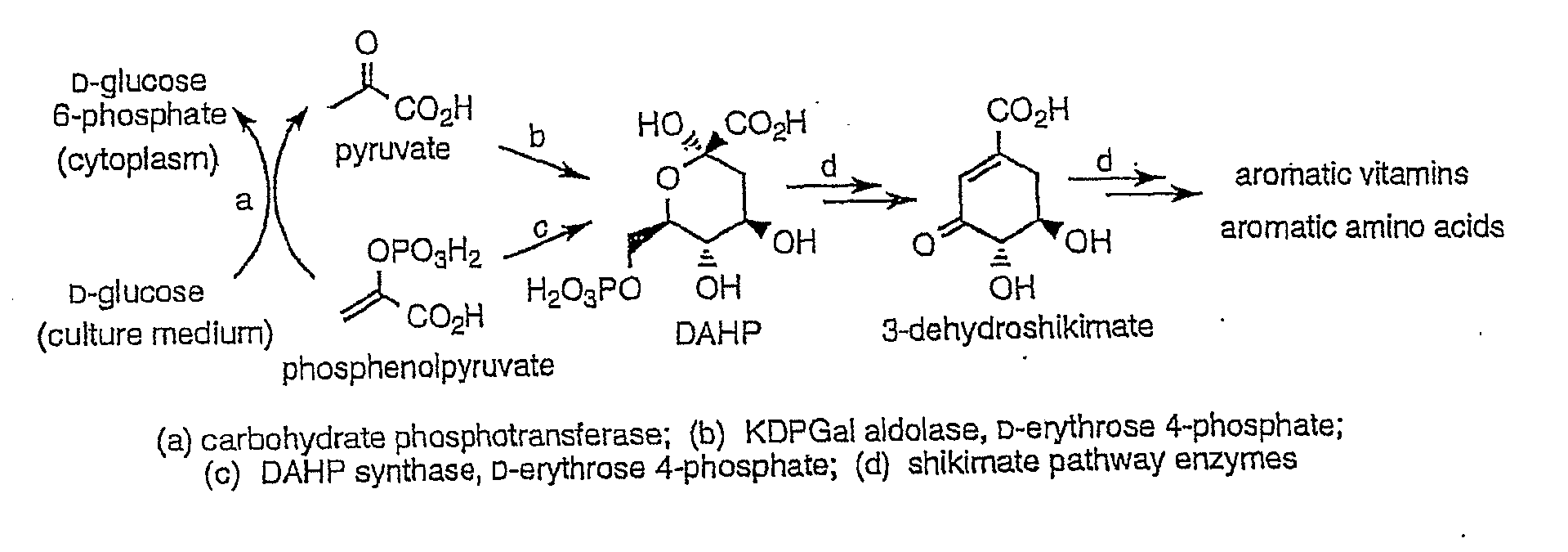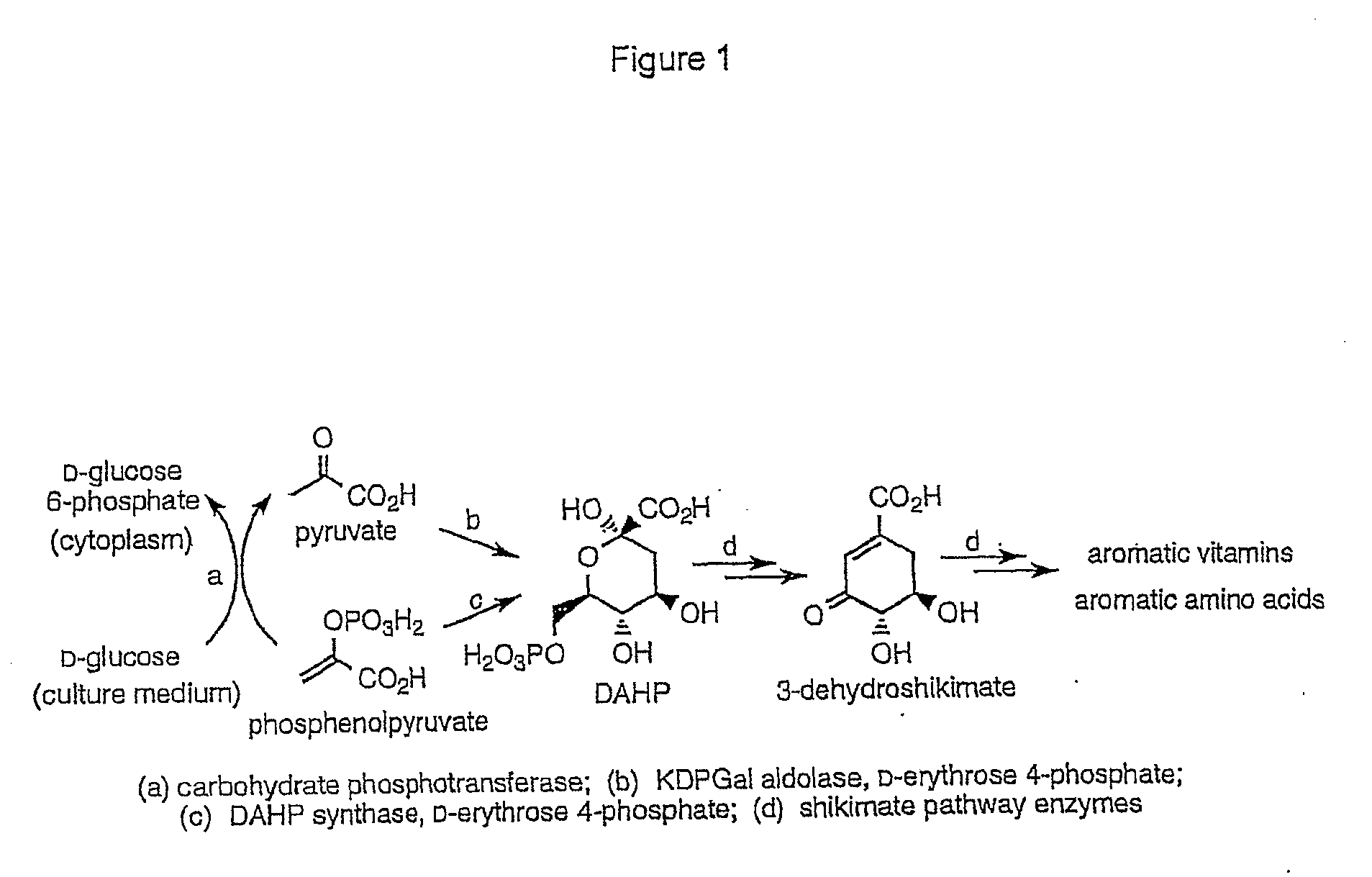Methods and Materials for the Production of Shikimic Acid
a technology of shikimic acid and materials, applied in the direction of lysine, antibiotics, drug compositions, etc., can solve the problem of limiting the concentration and yield of natural products microbially synthesized through the shikimate pathway
- Summary
- Abstract
- Description
- Claims
- Application Information
AI Technical Summary
Benefits of technology
Problems solved by technology
Method used
Image
Examples
specific example 2
[0080]Cloning and Characterization of dgoA Genes from other Bacterial Sources.
[0081]E. coli wild-type dgoA-encoded KDPGal aldoalse showed weak activity toward accepting D-erythrose 4-phosphate as a substrate. KDPGal aldolases from other bacterial sources might have higher activities for catalyzing the condensation of pyruvate with D-erythrose 4-phosphate. Obtaining dgoA genes from other bacteria would also enable a cross-species DNA family shuffling that has been reported to improve enzyme performance rapidly. Although KDPGal aldolase activities have been identified in Pseudomonas saccarophila, Pseudomonas cepacia, Caulobacter cresentus, Azotobacter vinelandii, Rhizobium meliloti, Gluconobacter liquefaciens, and nonpathogenic Mycobacteria, none of these dgoA gene sequences was known except in Caulobacter cresentus in which the genomic sequence has been obtained. See: Crameri, A. et al., Nature 1998, 391, 288-291; Kurn, N. et al., J. Bacteriol. 1978, 135, 517-520; Wong, T. Y.; Yao, X...
specific example 3
Directed Evolution of KDPGal Aldolases
[0086]The dgoA genes of E. coli, K. pneumoniae, and S. typhimurium were each evolved by use of error-prone PCR and DNA shuffling. E. coli dgoA and K. pneumoniae dgoA and were subjected to two rounds of error-prone PCR mutagenesis followed by one round of DNA shuffling. Identification of increased activity relative to condensation of pyruvate with D-erythrose 4-phosphate was based on a selection that increased in stringency with each round of directed evolution.
[0087]The activity of the resulting KDPGal aldolases in catalyzing condensation of pyruvate and D-erythrose 4-phosphate was investigated in E. coli CB734, which lacks all isozymes of DAHP synthase. Thus, growth of E. coli CB734 on glucose-containing minimal salts medium required supplementation with L-phenylalanine, L-tyrosine, L-tryptophan and aromatic vitamins (entry 1, Tables 2-4, below).
TABLE 2Directed Evolution of E. coli KDPGal aldolase.EntryConstructaM9bM9cFdYFdYFWdYFWvitd1E. coli C...
specific example 5
[0099]Characterization of Pyruvate-Based Shikimate Synthesis Pathway in vivo
[0100]To examine the functioning of created shikimate pathway variant in intact microbes, growth rates and synthesis of 3-dehydroshikimate were examined. E. coli CB734 / pEC03-1 and E. coli CB734 / pKP03-3 were completely dependent on plasmid-encoded, evolved DgoA isozymes EC03-1 and KPO3-3, respectively, for the formation of DAHP, E. coli CB734 / pNR7.126 relied on plasmid-encoded, feedback-insensitive AroFFBR for DAHP synthase activity. When cultured under identical conditions where growth was dependent on de novo synthesis of aromatic amino acids and aromatic vitamins, E. coli CB734 / pEC03-1 and E. coli CB734 / pKP03-3 entered the logarithmic phases of their growths 36 h and 12 h, respectively, later than E. coli CB734 / pNR7.126 This is depicted in FIG. 4, showing growth in the absence of aromatic amino acid and aromatic vitamin supplements in glucose-containing minimal salts medium under shake-flask conditions: E....
PUM
 Login to View More
Login to View More Abstract
Description
Claims
Application Information
 Login to View More
Login to View More - R&D
- Intellectual Property
- Life Sciences
- Materials
- Tech Scout
- Unparalleled Data Quality
- Higher Quality Content
- 60% Fewer Hallucinations
Browse by: Latest US Patents, China's latest patents, Technical Efficacy Thesaurus, Application Domain, Technology Topic, Popular Technical Reports.
© 2025 PatSnap. All rights reserved.Legal|Privacy policy|Modern Slavery Act Transparency Statement|Sitemap|About US| Contact US: help@patsnap.com



